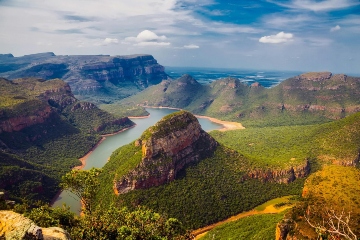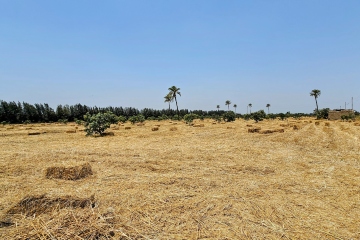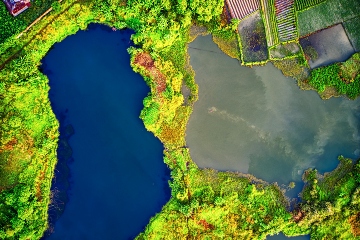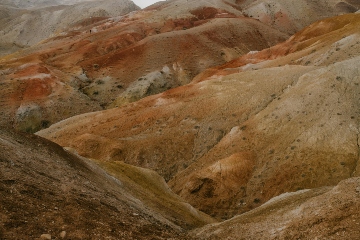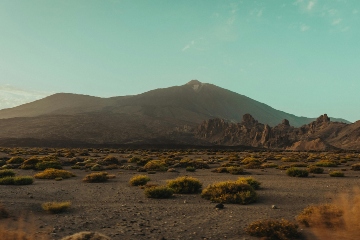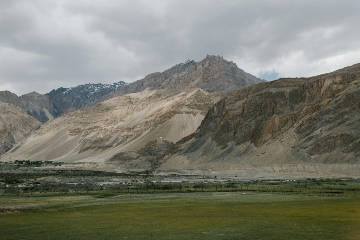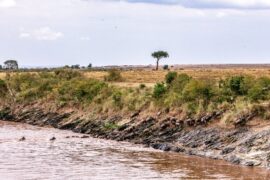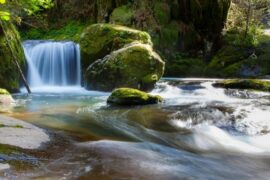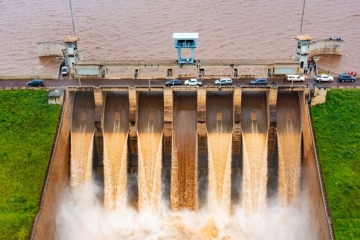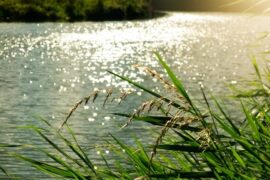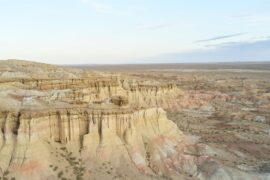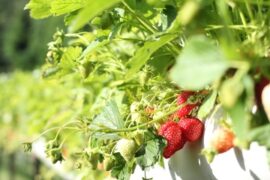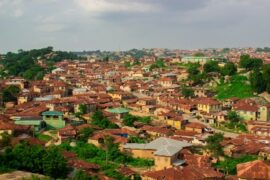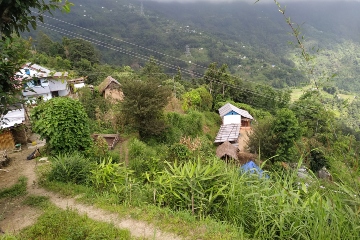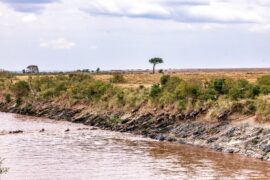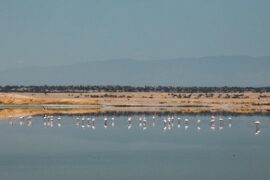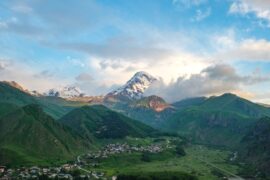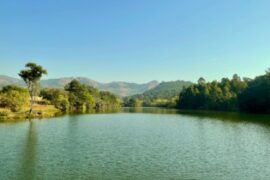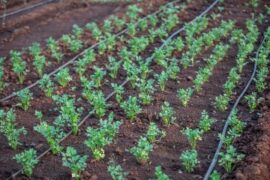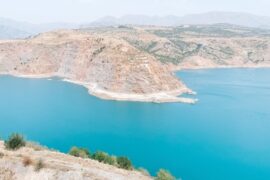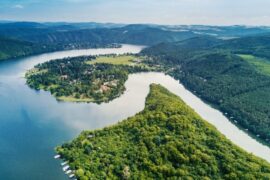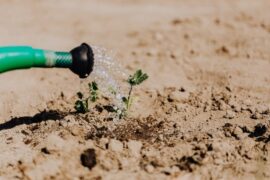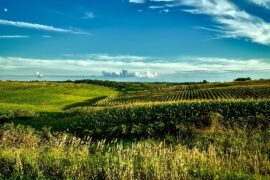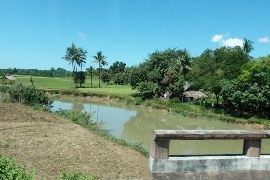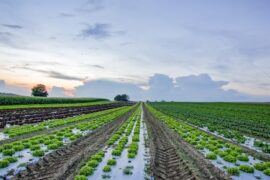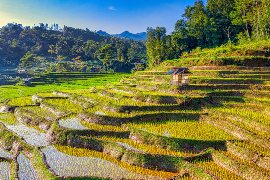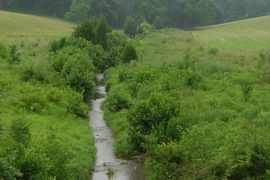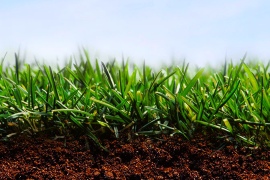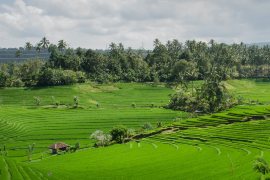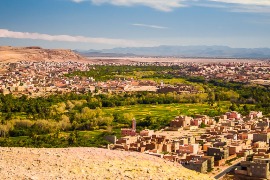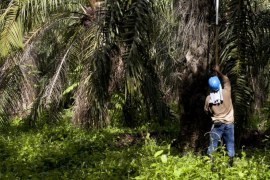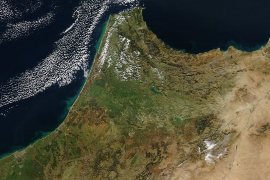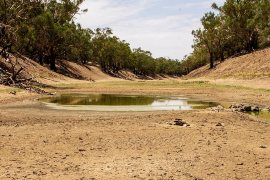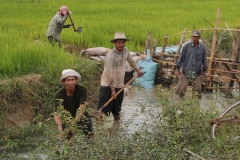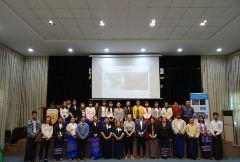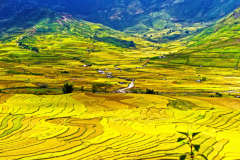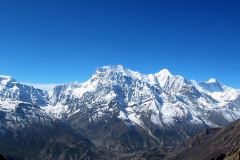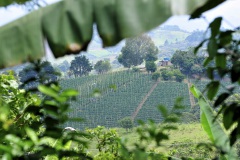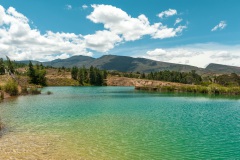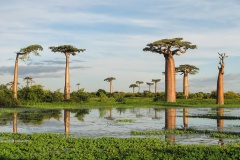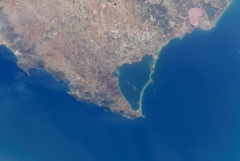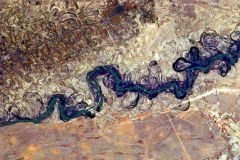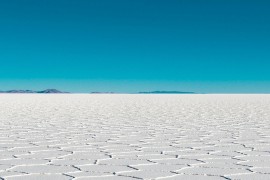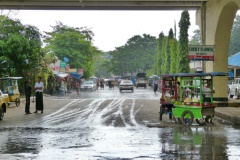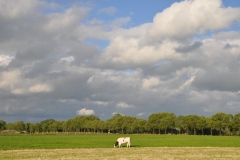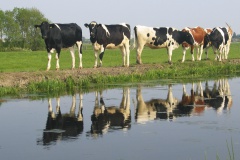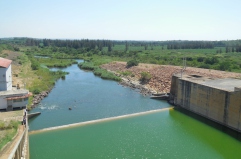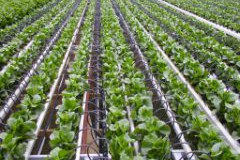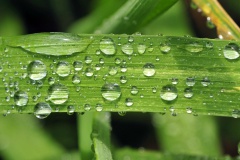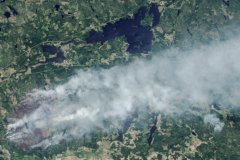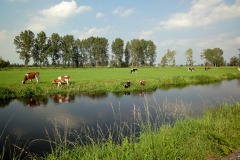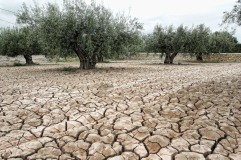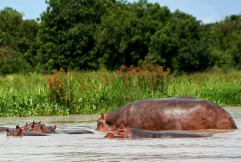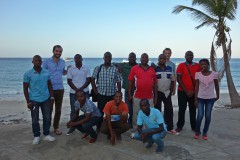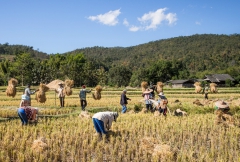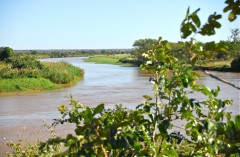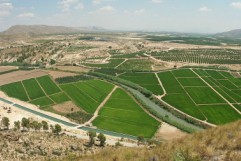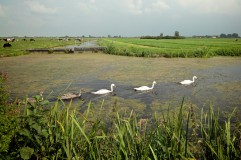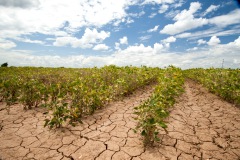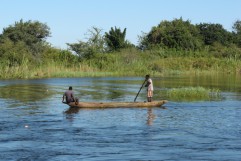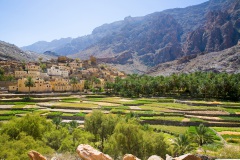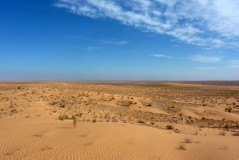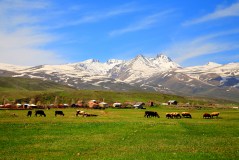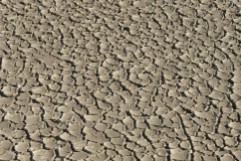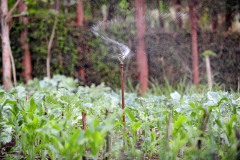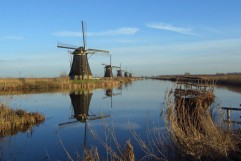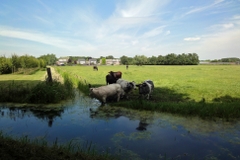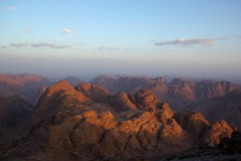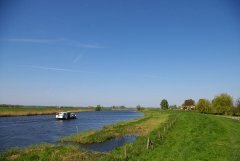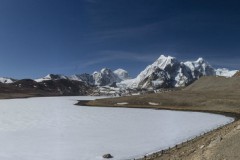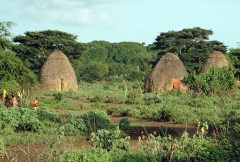Uitdaging
Periodes van neerslagtekort (droogte) in combinatie met de onbalans in (periodieke) waterbeschikbaarheid en waterverbruik kunnen de water- en voedselzekerheid van veel regio’s wereldwijd in gevaar brengen. Dit is vooral relevant in semi-aride en subtropische regio’s (meer dan 40% van de wereldbevolking). De risico’s voor water- en voedselzekerheid zullen naar verwachting toenemen als gevolg van klimaatverandering en een toenemende bevolkingsgroei. Het verminderen van de kwetsbaarheid van regionale en lokale economieën door het begeleiden van duurzamer land- en watergebruik, naast betere strategieën over waterverdeling, vormt de hoeksteen van de FutureWater-aanpak in haar poging om een zachte overgang naar meer adaptieve en veerkrachtige economieën te bevorderen.
FutureWater-aanpak
- Het verstrekken van klimaatrisico- en kwetsbaarheidsbeoordelingen op basis van nieuwe risicogebaseerde benaderingen (bijvoorbeeld het “bottom-up” beslissingskader dat door de Wereldbank wordt ondersteund) om de belangrijkste oorzaken van waterschaarste en hun rol bij het genereren van sociaaleconomische en milieueffecten te identificeren. Deze analyses worden gebruikt om te informeren over investeringen en te adviseren over beheer- en aanpassingsbeleid. Ze worden toegepast op meerdere ruimtelijke schaalniveau’s, van het bedrijfs- en irrigatiedistrictsniveau tot stroomgebied en grensoverschrijdende regio’s
- Ontwikkeling van beslissingsondersteunende systemen die operationele satellietgebaseerde en social-media monitoringtools combineren, prognosemogelijkheden, hydrologische en water-allocatiemodellen en de nieuwste wetenschappelijke kennis over relevante droogteprocessen. FutureWater’s “Drought and Water Scarcity Decision Support System” integreert al deze componenten in één toolbox. Hiermee kan de verwerking van gegevens in de cloud worden geoptimaliseerd en kunnen resultaten worden geintegreerd en gepresenteerd op een snelle en efficiënte manier die toegankelijk is voor de eindgebruiker.
Gerelateerde projecten
-
WEAP Permits Tool ARA-SUL
FutureWater is carrying out an assignment to improve the WEAP-Permits Tool, which supports ARA-Sul in evaluating water use licenses in the Pequenos Libombos area. This project builds on earlier efforts, refining the tool based on feedback from ARA-Sul’s technical professionals. By embedding the tool within ARA-Sul’s operations, FutureWater aims to...
-
BUCRA: Building Unity for Climate Resilient Agriculture
Het BUCRA-project versterkt kleinschalige boeren in de Nijldelta van Egypte met klimaatslimme landbouwpraktijken en geavanceerde digitale tools. Met behulp van FutureWater's Croptimal en SOSIA optimaliseert het project de gewaskeuze en irrigatie-efficiëntie, waarmee het inspeelt op waterschaarste en klimaatverandering. Demonstratiepercelen en op maat gemaakte trainingen stimuleren duurzame en veerkrachtige landbouw.
-
Slim waterbeheer voor krachtige beslissingen in de WEFE-nexus
Effectieve besluitvorming in het beheer van waterbronnen wordt vaak belemmerd door het gefragmenteerde gebruik van verschillende benaderingen in verschillende sectoren (water, energie, voedsel en milieu). Deze versnippering leidt tot inconsistente gegevens, inefficiëntie, tegenstrijdige resultaten en problemen met geïntegreerde planning. Om deze situatie te verhelpen, willen de regionale kantoren van de...
-
Water Accounting in Mongolia
Water Accounting offers data-driven insights into water availability, use, and allocation, helping policymakers balance demands across sectors like agriculture, industry, and urban development. It supports sustainable growth by ensuring efficient water use while protecting resources for the future. By accounting for different interventions and projections, it offers climate-resilient water resources...
-
NbS for Drought Resilience in Latin America
Under this project, FutureWater supports the World Bank to fill an existing knowledge gap regarding the applicability and potential effectiveness of Nature-based Solutions to reduce risks of droughts, with a focus on Latin America. A set of NbS factsheets and an inventory of useful tools were compiled by exploring a...
-
Climate Strategy Central and West Asia
The regional knowledge and support technical assistance project "Delivering a Climate Change Strategy for Central and West Asia" supports the delivery of a Climate Change Strategy and an Action Plan for Central and West Asia to strengthen integration of climate change considerations in Asian Development Banks (ADB) financed interventions in...
-
Monapo Catchment Water Allocation Model in Support of ARA-Norte in Mozambique
The aim of this project is to advance water system analysis for ARA-Norte, the regional water administration authority in Mozambique, focusing on the Monapo Catchment. In collaboration with ARA-Norte's hydrologists, we're crafting a Water Allocation Model employing the Water Evaluation And Planning (WEAP) system.
-
Climate Change Adaptation Scoping Assessment for Turkmenistan
The project aims to facilitate the identification and conceptualization of projects focused on climate adaptation, particularly enhancing resilience in Turkmenistan's water and agriculture sectors. This involves creating maps of climate-related hazards to engage with government and development partners. The mapped climate risks will serve as a foundation for discussions on...
-
Updating the Operational Water Allocation Model for the Pequenos Libombos Reservoir for ARA-Sul
This project supports ARA-Sul (Administração Regional de Águas do Sul) in the licensing of water users in the Pequenos Libombos Reservoir area, FutureWater, in a project commissioned by Blue Deal Mozambique, updated the operational WEAP water allocation model, originally developed in 2014, to reflect the 2023 water demand and hydrological...
-
Klimaatbestendige beoordeling en investeringsanalyse in het Limpopo-bekken
Het hoofddoel van deze studie is om de ontwikkelingsscenario's voor watervoorraden die in de Limpopo Scoping Study (2010) en de Limpopo Monograph (2013) zijn overwogen, te herzien om geactualiseerde toekomstige ontwikkelingsscenario's te produceren en deze te evalueren in termen van sociale, economische en milieuvoordelen, inclusief verbeterde klimaatbestendigheid en gemengde grijze...
-
Sustainable Water Resources Management in Mongolia
In Mongolia, the continental semi-arid to arid climate of most of the territory results in low water availability, with the southern region particularly affected by a lack of perennial rivers and reliance on fossil groundwater reservoirs, where recharge is negligible. Climate change and increasing water demand are further threatening future...
-
Catchment Assessment for Water Stewardship Plan
Highly productive berry farms and water scarcity are causing conflicts with the environmental assets and values of the Doñana National Park, Spain. There is growing interest in the agricultural sector to reverse this situation by implementing a water stewardship program. A catchment assessment is needed to produce baseline information to...
-
Pre-Feasibility Work to Identify Nature-based Solutions for Multiple Catchments in Nigeria
This project will involve working across two fee-for-service engagements with the Coca Cola Corporation and Diageo in Nigeria. The identification and prioritisation of NbS for implementation will be achieved through the development of three key products: two prefeasibility analyses for Ogun and Oshun catchments, and a high-level country-wide strategic assessment...
-
RoSPro: Roadside Spring Protection to Improve Water Security in Nepal
De midden- en hooggelegen gebieden in de Himalaya hebben te kampen met waterschaarste, waardoor ze een van de meest kwetsbare regio's ter wereld zijn. Bronnen zijn essentiële levensaders voor miljoenen berggemeenschappen en vormen de primaire bron voor huishoudelijk water en lokale voedselzekerheid. Helaas is het debiet van bronnen in de...
-
Water Evaluation And Planning Training for the Umbeluzi Catchment
ARA-Sul is improving their decision-making procedures. One component is improved water allocation planning. FutureWater has developed for the Umbeluzi two Water Allocation Models (WAMs) in 2014. A refreshing workshop for water managers and decision makers was held in June 2023.
-
WEAP Ground Water Modelling in Mozambique
Groundwater availability is critical to the Umbeluzi Catchment. Currently, there is a need for a simple tool that can asses the availability of resources in the ground. This especially to asses the permits for groundwater extractions. It is expected that a simplified modelling approach can provide a trend analysis sufficient...
-
Developing the CAREC Water Pillar: Climate Change Assessment for Georgia
The Central Asia Regional Economic Cooperation (CAREC) Program has initiated the development of a Water Pillar, an investment mechanism aimed at enhancing water infrastructure and capacity development to generate regional benefits. Expanding from the initial scoping study conducted for the five Central Asian countries in 2021, this project now shifts...
-
GLOW: Global Water Availability Forecasting Service to Support Water Security
The GLOW project aims to pilot an operational service that provides timely and easy access to current and forecasted water availability and demand across the entire Maputo River and the Black Umbeluzi River Basins.
-
MAGDA: Meteorological Assimilation from Galileo and Drones for Agriculture
Het MAGDA-project heeft als doel een geïntegreerd - maar modulair - systeem te leveren voor het maken van voorspellingen van zwaar weer en irrigatieadviezen, verbeterd door middel van verschillende satelliet-, drone- en grondtechnologieën voor het observeren van het weer. De belangrijkste toepassingen zullen bestaan uit waarschuwingen voor zwaar weer dat...
-
Strategic Climate Adaptation Planning for the Amu Darya Basin in Uzbekistan
Uzbekistan's water resources depend to a large extent on those provided by the transboundary Amu Darya river which are fully allocated and highly sensitive to climate change and water demand and management changes. Especially the agricultural sector, but also the energy and urban water supply sector need to transform into...
-
SOS-Water: Water Resources System Safe Operating Space in a Changing Climate and Society
Het SOS-Water Project probeert de grenzen aan te geven waarbinnen de capaciteit van de aarde om levensondersteunende systemen voor de mensheid te leveren niet in gevaar komt en de capaciteit van de mensheid om zich aan te passen aan milieuveranderingen niet overbelast raakt. Het overschrijden van dergelijke drempels of omslagpunten...
-
BONEX: Boosting Nexus Framework Implementation in the Mediterranean
BONEX is een project dat wordt gefinancierd door de PRIMA-EU Foundation, speciaal voor het Middellandse Zeegebied. Deze regio staat voor verschillende uitdagingen om voedsel- en waterzekerheid in de toekomst te garanderen en tegelijkertijd ecosystemen te behouden. BONEX onderzoekt en ontwikkelt specifieke oplossingen die de koppeling van governance met de praktijk...
-
Identification of Land Degradation and Climate Change Hotspots
This projects entails a risk assessment of selected value chains in the context of progressing climate change which is expected to impact on degradation processes in dryland agriculture over the next decades. A global-scale assessment of the potential impact of climate change on land degradation is performed. Per-country estimates of...
-
Advancing the Monitoring of Water-Related SDGs in Myanmar: an Issue Brief
This assignment entails the write-up of an issue brief on SDG 6 monitoring in Myanmar with Earth Observation (EO) technologies. Based on the status of data availability in Myanmar and the potential of innovative technologies and datasets, examples are given of how current knowledge gaps can be addressed. In addition,...
-
CREATE: Cross-Border Climate Vulnerabilities and Remote Impacts of Food Systems of the EU, Turkey and Africa
Knowledge and research on cross-border climate vulnerabilities and impacts of a geographic area is still a new topic in scientific literature. Nowadays, climate risk and impact assessments of food-systems focus typically on the production within a geographic area only. Consequently, knowledge and research on the cross-border climate vulnerabilities of food-systems...
-
Training on Real Water Savings for FAO’s Regional Water Scarcity Program
The Regional Office for Asia and the Pacific (RAP) of the Food and Agriculture Organization of the United Nations (FAO) has recently secured funds to continue a program of training on ReWaS, which is a simple tool to estimate the potential for generating real water savings from various agronomic, water...
-
Technical Annexes on Nature-based Solutions for Water Security
The Nature Conservancy (TNC) is producing technical modules and guidance documentation to enable water sector actors and their funders to invest in Nature-based Solutions for Water Security (NbS-WS). Part of the material being developed is a module on technical options, which will include annexes with key information for each of...
-
HiHydroSoil v2.0: Global Maps of Soil Hydraulic Properties at 250m Resolution
In 2016, FutureWater released a new dataset: HiHydroSoil v1.2, containing global maps with a spatial resolution of 1 km of soil hydraulic properties to support hydrological modeling. Since then, the maps of the HiHydroSoil v1.2 database have been used a lot in hydrological modeling throughout the world in numerous (scientific) projects. A few examples of...
-
Climate Risk Screening: Water Availability Indonesia
Indonesia is planning to use its water resources more extensively. Drinking water, irrigation and environmental flow requirements should be served and the baseline of how much water is available currently and under climate change should be known. FutureWater has developed a climate risk screening approach, based on a rapid assessment,...
-
Future Evapotranspiration in the Souss-Massa Basin
In this project, FutureWater used the outputs of the bias corrected "EuroCordex" RCM ensemble generated for IMWI in a previous work package. Using temperature and precipitation trends from this dataset for both past and future, an application of the Budyko methodology combined with the Modified Hargreaves approach was implemented to...
-
Efficient Irrigation of Oil Palms in Colombia
This is a feasibility study on the adoption of more efficient irrigation techniques by oil palm farmers in the Sevilla basin, one of the key basins in the Sierra Nevada, Colombia. The general objective is to identify the local environment at basin scale, the limiting factors and suitable field interventions...
-
Creating a Bias Corrected, Downscaled Climate Model Ensemble to Provide Future Climate Change Projections for Morocco
This project involved downloading and bias correcting Regional Climate Model (RCM) outputs from the EuroCordex ensemble. Firstly, RCM outputs were downloaded from the ESGF database and postprocessed to a standardised grid and time representation. Subsequently, bias correction was performed using a quantile mapping approach and ERA5-Land as the reference observational...
-
InfoSequia-4CAST: Forecasting and Quantifying Risks of Crop and Water Supply Failures Using Machine Learning and Remote Sensing
InfoSequia-4CAST combines historical and up-to-date observations of satellite-based meteorological and agricultural drought indices with climate variability indices, to generate seasonal outlooks of water supply and crop yield failure alerts. These impact-based indicators are computed using a simple, robust and easily understandable statistical forecasting-modelling framework. By making use of multi-sensor, state-of-the...
-
Transboundary water management between Thailand and Cambodia
Transboundary projects aid the development of effective water resource management (WRM) by helping to limit competition over resources and in creating a dialogue for the transferral of beneficial lessons between the countries. This project takes an integrated approach to support the development of a water resource management plan for a...
-
Tailor-Made Training for water professionals in Myanmar
This tailor-made training enhanced capacity of Yangon Technological University (YTU) educational staff in using Google Earth Engine to analyse water resources and support water management. Technical staff of Department of Meteorology and Hydrology (DMH) and the Department of Water resources and Improvement of River systems (DWIR) also participated to gain...
-
Training Package and Technical Guidance for Water Productivity and Real Water Savings
The overall project objective is to compile an inventory of agricultural field interventions and develop a training package to evaluate Real Water Savings from irrigated fields, to systems and basins. A guidance document is developed for agricultural field interventions by compiling a literature database containing published experiences and results of...
-
Pan-TPE: Changes in the Pan-Third Pole Water Tower
The proposed research targets changes in climate, water supply and demand, and suitable adaptation measures for green development of the Silk Road Economic Belt (SREB) in the river basins crossed by the SREB transect. Given the strong role of large scale hydrology in the proposed research activities, the spatial domain...
-
SMART-WADI: SMART WAter Decisions for Iran
The SMART-WADI project (SMART Water Decisions for Iran), carried out by a consortium of FutureWater, IHE-Delft, and local partner EWERI, focuses on farmers who irrigate their crops with groundwater. The aim is to provide up-to-date information and advice on water productivity, irrigation and farm management. The project combines the latest...
-
TWIGA: Transforming Weather Water data into value-added Information services for sustainable Growth in Africa
TWIGA aims to provide actionable geo-information on weather, water, and climate in Africa through innovative combinations of new in situ sensors and satellite-based geo-data. With the foreseen new services, TWIGA expects to reach twelve million people within the four years of the project, based on sustainable business models. The TWIGA...
-
HERMANA: Tool for Integrated Water Management
HERMANA aims to foster the development of an integrated water management decision support system (DSS) that supports daily, tactical and strategic decision-making related to water resources in Colombia, and specifically in the Cauca Valley Basin. The HERMANA tool will be a comprehensive system able to provide valuable, relevant, and reliable...
-
LAUREL: Land Use Planning for Enhanced Resilience of Landscapes
Deforestation, population growth, and climate change are only some of the challenges to sustainable landscape management in Madagascar. Severe impacts of land degradation on crop production, water availability and biodiversity are already observed and expected to exacerbate in the future. To address these challenges, the World Bank is supporting the...
-
Hydrogeological modeling of groundwater discharge to the Mar Menor lagoon
The groundwater discharge of irrigation return flows to the Mar Menor lagoon (Murcia, SE Spain), the largest coastal lagoon in Europe, is among one of the possible causes that would explain the high levels of eutrophication (hypereutrophication) and the several algal blooms accounted in this lagoon ecosystem in the last...
-
Climate Resilient Water Supply System for Uzbekistan
Uzbekistan is upgrading and further developing its domestic water supply system in the western part of the country (Republic of Karakalpakstan). Tthe water supply system must be full climate proof in design and operations. The Green Climate Fund (through the Asian Development Bank) will be asked to finance the climate...
-
DRR: Technical Assistance on Drought Information and Early Warning Systems
To address the recent drought problems in Bolivia, FutureWater and Deltares have been asked to provide recommendations on drought early warning and drought information systems, both on technical aspects as well as on institutional issues. The Dutch Risk Reduction Team has held stakeholder consultations with the Ministry of Environment and...
-
Leapfrogging Delta Management: Showcase operational rainfall monitoring
Significant decisions are to be made to manage and engineer the water systems in Myanmar and to develop large structural and non-structural projects (e.g. hydropower dams, urban water use, industrial development, extension of irrigation capacity, operational quantity and quality management, etc.). The Myanmar and Dutch governments have agreed to cooperate...
-
DAISY2: Daring Applications and Innovations in Sensor sYstems
DAISY2 builds on the success of the DAISY project in which a compact and mobile sensor system was developed aimed at different socio-economic applications like e.g. security, life-sciences, transport, logistics, and agro-food. Within DAISY2 we aim to further develop this sensor system and explore the viability of this products for...
-
CoMET: Slimme modelkoppeling voor betere actuele verdampingsschatting
Momenteel worden via het SAT-WATER initiatief verdampingsdata aangekocht die gebaseerd is op optische en thermische satellietbeelden. Zulke beelden zijn op bewolkte dagen echter niet beschikbaar, waardoor de berekening van de actuele verdamping niet optimaal uitgevoerd kan worden. Dit is een serieus obstakel voor het gebruik van satellietgebaseerde verdampingsdata voor het...
-
Optimalisatie van de waterverdeling binnen Waterschap Hunze en Aa’s
Tijdens droge zomerperiodes wordt er in de provincies rondom het IJsselmeer water aangevoerd, onder andere voor het op peil houden van de grondwaterstanden en beregening ten behoeve van de landbouw. In de meeste zomers is de buffercapaciteit van het IJsselmeer voldoende om aan alle watervragen te voldoen, maar in extreem droge zomers kan het voorkomen...
-
Training in Water Resources Modelling for ARA-Sul
A Tailor-Made Training on Water Resources Modelling was required to equip the staff of the water agencies in Mozambique (ARAs) with additional knowledge to have a stronger advisory role towards policy and decision makers, and people living in the area. FutureWater provided this training to ARA-Sul and ARA-Norte. This training...
-
BRIGAID: BRIdging the GAp for Innovations in Disaster resilience
Researchers, innovators and incubators develop innovative products and services to reduce the increased climate change risks. Many of these innovations, however, hardly arrive at the markets. BRIGAID BRIdges the GAp for Innovations in Disaster resilience. In the frame of BRIGAID, FutureWater contributes in two ways. Firstly, leading the coordination of...
-
Water2Invest Regional Demonstrator
To adapt to a changing climate governments, regional development banks, international donors and investors require information on where adaptation measures are most effective and most feasible in a specific context. To make information more easily accessible to end users, the Climate-KIC innovation project Water2Invest developed an offline and online tool....
-
Satellietdatagebruik bij natuurbrandbeheersing
De afgelopen jaren hebben in Nederland verschillende grote natuurbranden plaatsgevonden. Ondanks dat de aangetaste arealen klein zijn in vergelijking met het buitenland, is het maatschappelijk risico groot vanwege de intensieve gebruiksfunctie van de natuur door recreatie, toerisme, houtproductie, militaire oefenterreinen, etc. Daarnaast grenst risicovolle vegetatie vaak aan snelwegen, spoorwegen, installaties voor drinkwatervoorziening en stedelijke bebouwing....
-
Marktverkenning informatieproducten voor waterschappen op basis van remote sensing
Remote sensing wordt in de ruimste zin van het woord gebruikt voor waarnemingen vanaf afstand en in de geo-informatica tot het gebruik maken van satellieten, vliegtuigen, en drones voor aardobservatie. Ondanks dat remote sensing technieken al meer dan een eeuw oud zijn (luchtballon sinds ~1860, vliegtuigen sinds ~1915, satellieten sinds ~1960, drones sinds ~2010) is...
-
IMPREX: IMproving PRedictions and management of hydrological EXtremes
FutureWater leads the coordination of the “Agriculture and Drought” sectoral Work Package of IMPREX. This WP specifically aims to study and evaluate the use of IMPREX weather forecasts and predictions, climate variability, and drought indicators to assess agricultural drought risk and impacts over four case studies and at the pan-European...
-
Preliminary Study for a Payment for Watershed Services Scheme
This project pilots a Payment for Watershed Services (PWS) scheme in the Rwenzori Mountains National Park (RMNP) in Uganda. The goal of the pilot is to study the feasibility of the PWS scheme in the watersheds of the Mubuku and Nyamwamba rivers and supporting nature conservation and a healthy watershed...
-
Training in Water Resources and Allocation Models
A Tailor-Made Training was provided to three ARAs in Mozambique, being ARA-Centro (Beira), ARA-Centro-Norte (Nampula), and ARA-Norte (Pemba). The provided Tailor-Made Training focused on learning to work with a Water Resources and Water Allocation Model, and apply them to a catchment in Mozambique. Emphasis was put on how these tools...
-
Inclusive Development Paths for Healthy Red River Landscapes
Rapid land use changes in the Red River Basin threaten water resources. This project will be working in the Day River Catchment, a Red River distributary important for Hanoi, where most of these problems are manifest. The project will develop equitable and economically viable pathways for the land and water...
-
Water Allocation Model Development to Support Decision Making Procedures
Two water allocation models were developed in this project as a tool to support policy evaluation and improve strategic and operational decision making procedures of ARA-Sul, which is one of the five water management organizations in Mozambique. WEAP (Water Evaluation And Planning) was chosen as modelling framework. Different scenarios were...
-
ASSET: Accounting System for the SEgura river and Transfers
Semiarid coastal regions, as the Southeastern of Spain in which the Segura River Basin is located, are expected to be more affected by climate change and the resulting aggravation of water scarcity, droughts and desertification than other regions. In this project the interactions between the economy and the hydrological system...
-
Bodemvochtgegevens ter ondersteuning van Leverbot analyses
De Gezondheidsdienst voor Dieren (GD) heeft in de afgelopen jaren een analyse van leverbotbesmettingen uitgevoerd. Dit onderzoek heeft laten zien dat verschillende omgevingsfactoren een rol spelen zoals grondwaterstand, neerslag, temperatuur en bodemtype. Daarnaast is op basis van landsdekkende bodemvochtschattingen door FutureWater vastgesteld dat ook bodemvocht en leverbotbesmettingen gecorreleerd zijn, wat...
-
Water and Climate Services for Transboundary Water Management and Disaster Risk Management
During this pilot project the applicability of the in-house developed Drought Monitoring and Impact Assessment Toolbox (DMIAT) and HiP2P rainfall downscaling methodology were demonstrated for the Red River Basin in Vietnam. Furthermore the first steps in developing an integrated product for transboundary water management in the Red River Basin were...
-
SWIMM: Soil Water evaluation system based on Integrated Measurements and Modelling
The main objective of the project was to support policy making, under current and future climate conditions, on optimal water management in nature reserve areas, based on uniform and consistent data collection. The project built upon knowledge developed under the “Klimaat voor Ruimte” framework and refined and demonstrated a method,...
-
OWASIS-UK: Observatory of Water Availability – System of Integrated Services
The main objective of this study is to explore the potential to combine optical and gravity data from Earth Observation with meteorological data, together with innovative in situ sensors, hydrological modelling and crowd sourcing technologies, and the advanced visualization of the information through situation awareness platforms and decision support tools,...
-
GEISEQ: Toolbox for the surveillance and the efficient management of droughts
The GEISEQ project aims to develop a Decision Support System for Drought Management integrating a set of tools for: a) the detection, surveillance and monitoring of drought periods, b) the prediction and spatial analysis of their potential impacts, and c) supporting users and decision makers on the best and more...
-
Water Planning Tools to Support Water Governance
ARA-Centro is one of the five regional water management organizations in Mozambique and has to advise on the water availability and the required number of reservoirs that are needed to make the envisioned economic developments possible. For this advisory role, tools are needed like a water allocation model that can...
-
Review of the First Hydroponic Greenhouses Project at Barka, Oman
Oman is one of the world’s most arid countries where water availability fully relies on groundwater resources and desalinization plants. The average annual rainfall depth has been estimated is around 60 mm, varying from less than 20 mm in the internal desert regions to over 300 mm in the mountain areas. This rainfall on mountain...
-
Green Water Credits demonstration project Algeria
In cooperation with Algerian partners the “La Mina” basin was selected to demonstrate the potential for Green Water Credits (GWC) in Algeria. GWC can be seen as an investment mechanism for upstream farmers to practice soil and water management activities that generate benefits for downstream water users, which are currently...
-
Towards a Mekong Delta Portal
Studies have shown that the Mekong Delta is very vulnerable to floods and droughts, which will intensify due to climate change. Currently, these threats are not adequately monitored and information on such threats is inconsistent and only scattered available. Therefore Vietnam is in need of data sharing systems and advanced...
-
Water2Invest: Climate Investment Support Portal
In this project a web-based service was built from which it is possible to select a country or region on a global map, calculate the current water availability from surface water and groundwater as well as current water demands from the three sectors (agriculture, industry, domestic) and to assess from...
-
Mainstream Climate Change Adaptation and Mitigation Into Agriculture in the Southern Caucasus
This study contributes to the agriculture sector climate change impact assessment and adaptation and mitigation strategy identification and evaluation. The study encompasses the three countries of the Southern Caucasus region: Armenia, Azerbaijan, and Georgia. The project also includes components for capacity building among in-country staff, and support of the World...
-
DMIAT: Drought Monitoring and Impact Assessment Toolbox for Vietnam
In this project a Drought Monitoring and Impact Assessment Toolbox (DMIAT) was developed for Vietnam in order to support their drought policy. A DMIAT is a combination of remote sensing, models, and decision trees. The DMIAT will help Vietnam to better understand past and current droughts, and how to act...
-
SIRRIMED: Sustainable Use of Irrigation Water in the Mediterranean Region
SIRRIMED project addressed issues related to sustainable use of water in Mediterranean irrigated agricultural systems, with the overall aim of optimizing irrigation water use. In this project FutureWater was actively involved in the development of a District Information System (DIS) and a Watershed Information System (WIS) for the Campo de...
-
Klimaat Adaptieve Drainage
Op 17 mei 2011 heeft FutureWater de opdracht gekregen van AgentschapNL, handelend in opdracht van het Ministerie van Infrastructuur en Milieu, voor het uitvoeren van een onderzoeks en ontwikkelingsproject onder de titel “KlimaatAdaptieve Drainage, een innovatieve methode om piekafvoeren en watertekorten te verminderen” (SBIR113008). Dit project wordt uitgevoerd in het kader van de Small Business...
-
Deltaplan Hoge Zandgronden voor een klimaatbestendig regionaal watersysteem
Het veranderende klimaat heeft mogelijk grote gevolgen voor de hoge zandgronden in Zuid-Nederland. Naast dat er waarschijnlijk meer aanpassingen nodig zijn om om te kunnen gaan met grote hoeveelheden neerslag in een korte tijd, moet er ook geanticipeerd worden op een langere en extreme perioden van droogte. Waar het anticiperen op extreme neerslag veelal kan...
-
Application of Remote Sensing in National Water Plans: Demonstration cases for Egypt, Saudi-Arabia and Tunisia
In the Middle-East, where water is extremely scarce national water plans are considered as a means to improved water resources planning, but the plans are often based on limited information and data and are always very much focused on water in rivers and groundwater, rather than considering all the components...
-
Verkennende klimaatstudie Waterschap Vallei en Eem
Het Waterschap Vallei en Eem is een klimaatstrategie aan het ontwikkelen om zich voor te bereiden op het veranderende klimaat op de langere termijn (2050-2100). Ter ondersteuning bij het tot stand komen van deze strategie is een verkennende klimaatstudie uitgevoerd. De resultaten van deze studie zijn verkregen door gebruik te maken van de huidige kennis...
-
Hydrological seasonal forecasts in mountaineous basins
This project focused on the hydrology and cryosphere of the Himalayas and dealt with the influence of snow cover of the Himalayas and the Tibetan plateau on Asian monsoon dynamics, and the possibility to forecast the strength of the monsoon and the hydrological effects in downstream areas.
-
Needs Assessment of Future ESA Satellites for Water Management in Southern Europe
At the beginning of the 21st century various tools based on Remote Sensing (RS) techniques from satellites to assist land management were developed. Yet, there were no real products dedicated for water management applications. However, around 2005 an increasing number of Remotely Sensed datasets and algorithms relevant to water managers...
-
Green Water Credits Mechanism to support sustainable water use in Africa
Green Water Credits can be seen as an investment mechanism for upstream farmers to practice soil and water management activities that generate benefits for downstream water users, which are currently unrecognized and unrewarded. FutureWater coordinated and carried out the biophysical assessment that quantified the impact of Green Water Credits practices...

